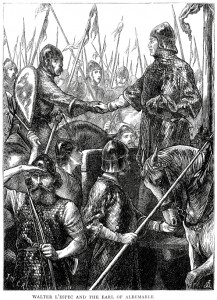Seven Leadership Styles

Alchemist
I’ve often thought of leadership as the ability to motivate people to work together toward a common goal. My definition is not far from Dwight Eisenhower’s quote: “Leadership is getting people to do something because they want to do it.”
Of course, there are different tactics to use in different situations. I study rhetoric – the art and science of persuasion – because I find it very helpful in convincing people that they want to do something. I also like to lay out goals and make them clear as possible. I’m not much of a yeller but I can understand (intellectually at least) how yelling might be a good leadership tactic in some situations – like an emergency.
I hadn’t thought much beyond that, so it was good to rediscover a 2005 Harvard Business Review article titled “Seven Transformations of Leadership”. The authors, David Rooke and William Torbert, identify seven “action logics” that can help us understand what kind of leader we already are.
I’ll summarize the seven here – using Rooke and Torbert’s terminology – partially because I think they’re important but also because I want to refer back to them in future posts.
Opportunists – “characterized by mistrust, egocentrism, and manipulativeness”, their goal is to win in any way possible. Only 5% of leaders are deemed to be opportunists (thankfully).
Diplomats – “seeks to please higher-level colleagues while avoiding conflict.” They rarely rock the boat and comprise about 12% of leaders.
Experts – “try to exercise control by perfecting their knowledge … watertight thinking is extremely important.” Experts comprise the largest single group of leaders, about 38%.
Achievers — “create a positive work environment and focus … on deliverables, the downside is that their style often inhibits thinking outside the box.” About 30% of leaders are achievers.
Individualists – often seen as “wild cards” with “unique and unconventional ways of operating”. Yet they also “contribute unique practical value” and “communicate well with people who have other action logics.” They make up about 10% of leaders.
Strategists – “focus on organizational constraints and perceptions, which they treat as discussable and transformable.” They are “highly effective change agents” but account for only 4% of leaders.
Alchemists – are able to “renew or reinvent themselves in historically significant ways.” They have “an extraordinary capacity to deal simultaneously with many situations at multiple levels.” Rooke and Torbert identify Nelson Mandela as an exemplar of the alchemist, which may help explain why only 1% of leaders fit the category.
Should We Work?

What? I still have to work?
Which of these two government policies is most appropriate for the next 50 years?
- Strive to reduce unemployment; aim for 4% unemployment.
- Eliminate the need to work; aim for 100% unemployment.
It’s a question we’ll need to wrestle with soon. It appears that we’re at the beginning of another great wave of job destruction. The last wave, starting roughly in 1980, eliminated or outsourced blue collar and clerical jobs. We used to have secretaries; now we have word processing software. We used to have factory workers; now we have robots.
The next wave will eliminate white collar jobs. This will happen in two ways:
Type 1 – through advanced communications and software support, a small number of “augmented knowledge workers” can do the work of thousands of traditional knowledge workers.
Type 2 – machines and systems will become smart enough to replace many knowledge workers.
I’ll illustrate with two examples from my life.
Type 1: The MOOCs. Massive Online Open Courses find very talented professors and augment them. With video, web, and online testing support, these professors can literally reach thousands of students. They give great lectures. (You should watch them). Why do we need other professors to cover the same material? A few professors can replace thousands. By the way, this will also accelerate the dominance of English.
Type 2: Automated Essay Grading. I’m rather proud of my ability to read essays and make useful comments that help students think more clearly and communicate more effectively. So what? Within the next few years, we’ll see software systems that can do almost as good a job as I can. OK … maybe they could do it even better since they never get tired. I’ve always thought that this would be a difficult task to automate because it’s “fuzzy”. But computers are mastering fuzzy logic even as we speak.
Much of what we call “knowledge work” is actually easier to automate than essay grading. Any process based on rules is fairly easy to computerize. Deciding which stocks to buy or sell is a good example. It’s just a set of rules. So today, “quants” and high-speed computers dominate much of our stock trading.
Diagnosing an illness may be another good example. Today, as many as 15% of diagnoses made by humans are wrong. But diagnosis is just a rules-based process. Surely, a computer can do better.
Within the next three decades, we may well reach a point where nobody needs to work. So what will we do? Good question. Perhaps we should ask a computer.
Crowd Sourcing Your Mail

You’ve got chain mail.
Let’s say you want to send a package to my personal trainer, Alison. If you know two facts about me, you can have the package delivered for free. Fact 1: the local dairy delivers milk to my front door very early each Thursday morning. Fact 2: I see Alison every Thursday morning (after the milk is delivered).
So, if you could get the package to the dairy, the milkman could deliver it with my weekly supplies (without going out of his way). I could pick up the package (without going out of my way) and deliver it to Alison. Everybody is happy, nobody has gone beyond his or her normal routines, and the package is delivered quickly, efficiently, and cheaply.
How would you know those two facts about me? By following my Twitter feed. Yep, Twitter. By analyzing where my Twitter feeds come from, a system could conceivably track my whereabouts and predict where I might be at a given time. Theoretically, it could do this for thousands of people and plot an efficient series of hand-offs from one person to another. (I probably don’t tweet enough for this to work, but lots of people do).
The concept is known as TwedEx. It’s not here yet but it might soon be – you can read more about it here.
Here’s the creepy part, in my opinion. If a system can predict my movements based on my tweets, what can the government figure out based on the PRISM program?
Fran and Grover in Hawaii
 Today would be my parent’s 72nd wedding anniversary. That they got married on June 8, 1941 was something of an accident.
Today would be my parent’s 72nd wedding anniversary. That they got married on June 8, 1941 was something of an accident.
Fran and Grover grew up in small towns in southeastern Texas. Fran’s father died when she was nine and Fran grew up very close to the poverty line. Grover was a bit better off; his father was involved in local politics and small businesses.
Grover could afford to go to the local college, Texas A&M. At the time, A&M was an all-male, military school. Every student was in the “Corps” (ROTC), received extensive military training, and a commission as a 2nd lieutenant upon graduation. Graduates served a minimum of two years in the military.
Fran worked as a secretary at A&M. They met and dated for several years. Ultimately, Grover asked her to marry him. She turned him down, saying that she didn’t want to be a military wife. She did leave an opening though, suggesting that Grover go off, do his tour of duty and then come back home to see if she were still available.
Grover graduated as en electrical engineer but wasn’t deployed immediately. Finally, in late May 1941 he got his orders – he was being deployed to Hawaii. He went back to Fran and said, in essence, “Marry me now and I’ll take you to Hawaii.” Fran said, “Well… if that’s the way you put it … OK.”
They had to quickly organize a wedding; Grover had to ship out shortly. The church happened to be available on June 8, so they took the slot. Apparently they didn’t have time to arrange a photographer; I’ve never seen a picture of their wedding. They spent their honeymoon driving from Bryan, Texas to San Francisco where they shipped out (on the S.S. Lurleen) to Hawaii.
And that’s how they both wound up at Pearl Harbor.
Slaying a Dragon

Ooops … you missed a spot.
I’ve always worked for challenger companies; we were second or third or fifth in our market segments. We were punching upward, trying to slay the dragon at the top.
I don’t know why I never worked for a category leader like IBM or SAP. It would have been good experience. I did notice, however, that executives who came to my companies from category leaders were never very successful. They were supposed to show us how big companies worked. But they didn’t understand how challenger companies worked. They knew how to punch downward but not upward.
So, how do you punch upward? The best answer comes from classical literature. Here are four examples:
David and Goliath – David was outgunned and outmuscled. All he had was a rock so he had to find a place – a small place – where a rock would be effective. It turns out the place was right in the middle of Goliath’s forehead.
Achilles – Thetis, Achilles’ Mom, bathed him in a secret sauce that made him invulnerable. When she dipped him, however, she held him by the heel so no sauce touched him there. Where did his enemies aim?
Siegfried – The hero of the Nibelungs, a German tribe, Siegfried killed a dragon and bathed in its blood. As you may know, bathing in a dragon’s blood makes you invulnerable. Unfortunately, a leaf fell from a tree and settled in the small of his back. No dragon’s blood touched him there. Guess what happened to Siegfried.
The Death Star in Star Wars – ok…it’s not classical literature but the Death Star is invulnerable. Well … there’s this one small spot … which Luke just happens to find.
I was struck that all four epics tell essentially the same story. All giants have a weakness. It’s small but very vulnerable. If you attack anywhere else, you’ll be repelled. If you attack everywhere, you’ll be repelled. Your only chance to win is to find the weak spot, concentrate on it, and don’t get distracted.
That’s just what we tried to do in our challenger companies. In one case, we decided that our competitor’s weakness was the inflexibility of their software. We stressed the supple, flexible nature of our systems. In another case, our competitor was far too complex. We stressed the simplicity of our solution and even invented a cartoon character to tout the difference. In both cases, we had a lot of success though we never actually slew the dragon.
I see many small companies today trying to do far too much. The secret of punching upward – of slaying the dragon – is to do less, not more.